2015 NISSAN GT-R check engine light
[x] Cancel search: check engine lightPage 248 of 358
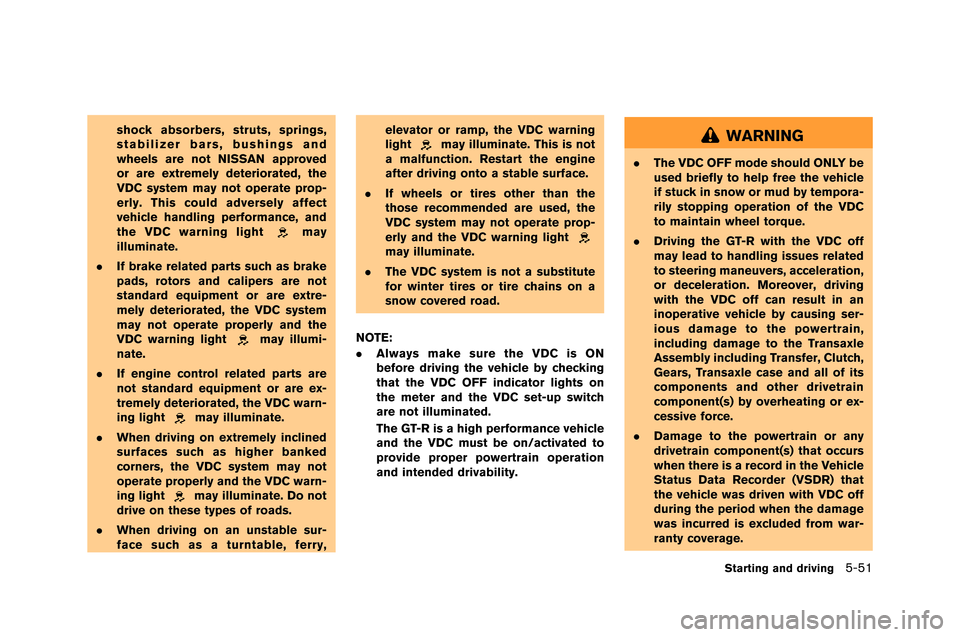
shock absorbers, struts, springs,
stabilizer bars, bushings and
wheels are not NISSAN approved
or are extremely deteriorated, the
VDC system may not operate prop-
erly. This could adversely affect
vehicle handling performance, and
the VDC warning light
may
illuminate.
. If brake related parts such as brake
pads, rotors and calipers are not
standard equipment or are extre-
mely deteriorated, the VDC system
may not operate properly and the
VDC warning light
may illumi-
nate.
. If engine control related parts are
not standard equipment or are ex-
tremely deteriorated, the VDC warn-
ing light
may illuminate.
. When driving on extremely inclined
surfaces such as higher banked
corners, the VDC system may not
operate properly and the VDC warn-
ing light
may illuminate. Do not
drive on these types of roads.
. When driving on an unstable sur-
face such as a turntable, ferry, elevator or ramp, the VDC warning
light
may illuminate. This is not
a malfunction. Restart the engine
after driving onto a stable surface.
. If wheels or tires other than the
those recommended are used, the
VDC system may not operate prop-
erly and the VDC warning light
may illuminate.
. The VDC system is not a substitute
for winter tires or tire chains on a
snow covered road.
NOTE:
. Always make sure the VDC is ON
before driving the vehicle by checking
that the VDC OFF indicator lights on
the meter and the VDC set-up switch
are not illuminated.
The GT-R is a high performance vehicle
and the VDC must be on/activated to
provide proper powertrain operation
and intended drivability.
WARNING
.The VDC OFF mode should ONLY be
used briefly to help free the vehicle
if stuck in snow or mud by tempora-
rily stopping operation of the VDC
to maintain wheel torque.
. Driving the GT-R with the VDC off
may lead to handling issues related
to steering maneuvers, acceleration,
or deceleration. Moreover, driving
with the VDC off can result in an
inoperative vehicle by causing ser-
ious damage to the powertrain,
including damage to the Transaxle
Assembly including Transfer, Clutch,
Gears, Transaxle case and all of its
components and other drivetrain
component(s) by overheating or ex-
cessive force.
. Damage to the powertrain or any
drivetrain component(s) that occurs
when there is a record in the Vehicle
Status Data Recorder (VSDR) that
the vehicle was driven with VDC off
during the period when the damage
was incurred is excluded from war-
ranty coverage.
Starting and driving5-51
Page 249 of 358
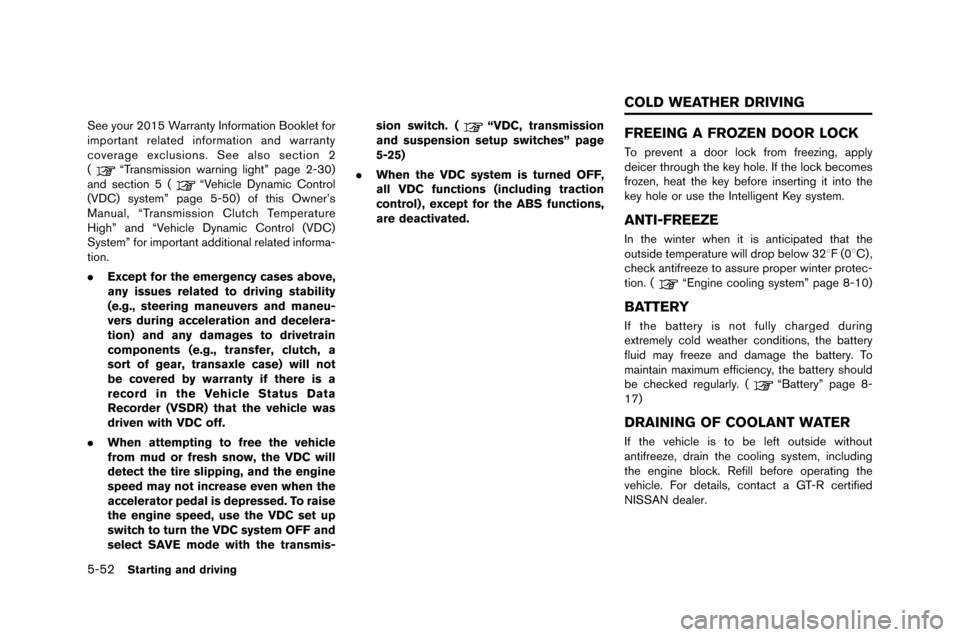
5-52Starting and driving
See your 2015 Warranty Information �fooklet for
important relate�b information an�b warranty
coverage exclusions. See also section 2
(
“Transmission warning light” page 2-30)
an�b section 5 (“Vehicle Dynamic Control
(VDC) system” page 5-50) of this Owner’s
Manual, “Transmission Clutch Temperature
High” an�b “Vehicle Dynamic Control (VDC)
System” for important a�b�bitional relate�b informa-
tion.
. Except for the emergency cases above,
any issues related to driving stability
(e.g., steering maneuvers and maneu-
vers during acceleration and decelera-
tion) and any damages to drivetrain
components (e.g., transfer, clutch, a
sort of gear, transaxle case) will not
be covered by warranty if there is a
record in the Vehicle Status Data
Recorder (VSDR) that the vehicle was
driven with VDC off.
. When attempting to free the vehicle
from mud or fresh snow, the VDC will
detect the tire slipping, and the engine
speed may not increase even when the
accelerator pedal is depressed. To raise
the engine speed, use the VDC set up
switch to turn the VDC system OFF and
select SAVE mode with the transmis- sion switch. (
“VDC, transmission
and suspension setup switches” page
5-25)
. When the VDC system is turned OFF,
all VDC functions (including traction
control) , except for the ABS functions,
are deactivated.FREEING A FROZEN DOOR LOCK
To prevent a �boor lock from freezing, apply
�beicer through the key hole. If the lock becomes
frozen, heat the key before inserting it into the
key hole or use the Intelligent Key system.
ANTI-FREEZE
In the winter when it is anticipate�b that the
outsi�be temperature will �brop below 328F (08C) ,
check antifreeze to assure proper winter protec-
tion. (
“Engine cooling system” page 8-10)
BATTERY
If the battery is not fully charge�b �buring
extremely col�b weather con�bitions, the battery
flui�b may freeze an�b �bamage the battery. To
maintain maximum efficiency, the battery shoul�b
be checke�b regularly. (
“�fattery” page 8-
17)
DRAINING OF COOLANT WATER
If the vehicle is to be left outsi�be without
antifreeze, �brain the cooling system, inclu�bing
the engine block. Refill before operating the
vehicle. For �betails, contact a GT-R certifie�b
NISSAN �bealer.
COLD WEATHER DRIVING
Page 256 of 358
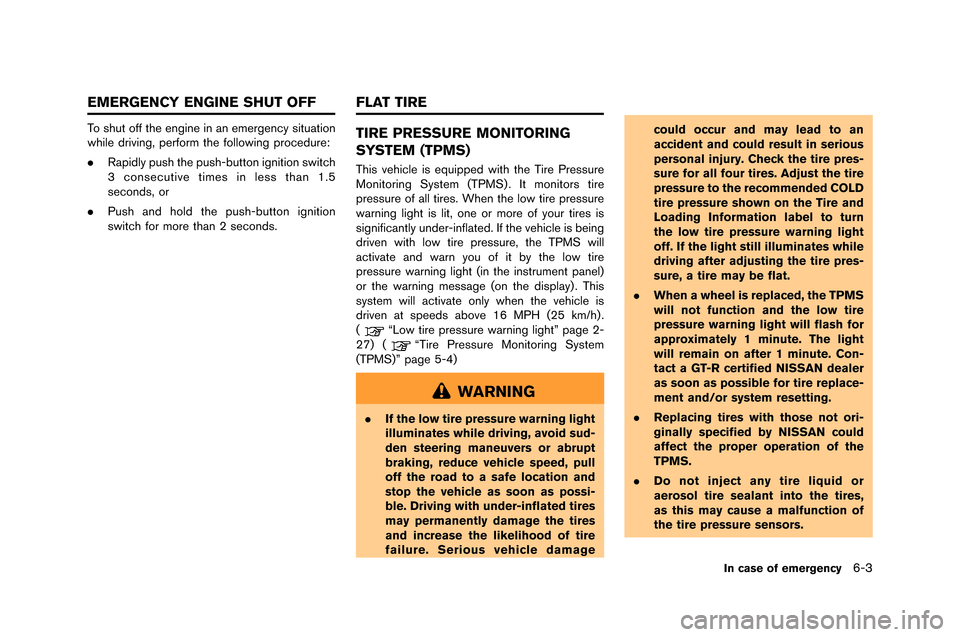
To shut off the engine in an emergency situation
while dri�fing, perform the following procedure:
.�bapidly push the push-button ignition switch
3 consecuti�fe times in less than 1.5
seconds, or
. Push and hold the push-button ignition
switch for more than 2 seconds.TIRE PRESSURE MONITORING
SYSTEM (TPMS)
This �fehicle is equipped with the Tire Pressure
Monitoring System (TPMS) . It monitors tire
pressure of all tires. When the low tire pressure
warning light is lit, one or more of your tires is
significantly under-inflated. If the �fehicle is being
dri�fen with low tire pressure, the TPMS will
acti�fate and warn you of it by the low tire
pressure warning light (in the instrument panel)
or the warning message (on the display) . This
system will acti�fate only when the �fehicle is
dri�fen at speeds abo�fe 16 MPH (25 km/h) .
(
“Low tire pressure warning light” page 2-
27) (“Tire Pressure Monitoring System
(TPMS)” page 5-4)
WARNING
. If the low tire pressure warning light
illuminates while driving, avoid sud-
den steering maneuvers or abrupt
braking, reduce vehicle speed, pull
off the road to a safe location and
stop the vehicle as soon as possi-
ble. Driving with under-inflated tires
may permanently damage the tires
and increase the likelihood of tire
failure. Serious vehicle damage could occur and may lead to an
accident and could result in serious
personal injury. Check the tire pres-
sure for all four tires. Adjust the tire
pressure to the recommended COLD
tire pressure shown on the Tire and
Loading Information label to turn
the low tire pressure warning light
off. If the light still illuminates while
driving after adjusting the tire pres-
sure, a tire may be flat.
. When a wheel is replaced, the TPMS
will not function and the low tire
pressure warning light will flash for
approximately 1 minute. The light
will remain on after 1 minute. Con-
tact a GT-R certified NISSAN dealer
as soon as possible for tire replace-
ment and/or system resetting.
. Replacing tires with those not ori-
ginally specified by NISSAN could
affect the proper operation of the
TPMS.
. Do not inject any tire liquid or
aerosol tire sealant into the tires,
as this may cause a malfunction of
the tire pressure sensors.
In case of emergency6-3
EMERGENCY ENGINE SHUT OFF FLAT TIRE
Page 276 of 358
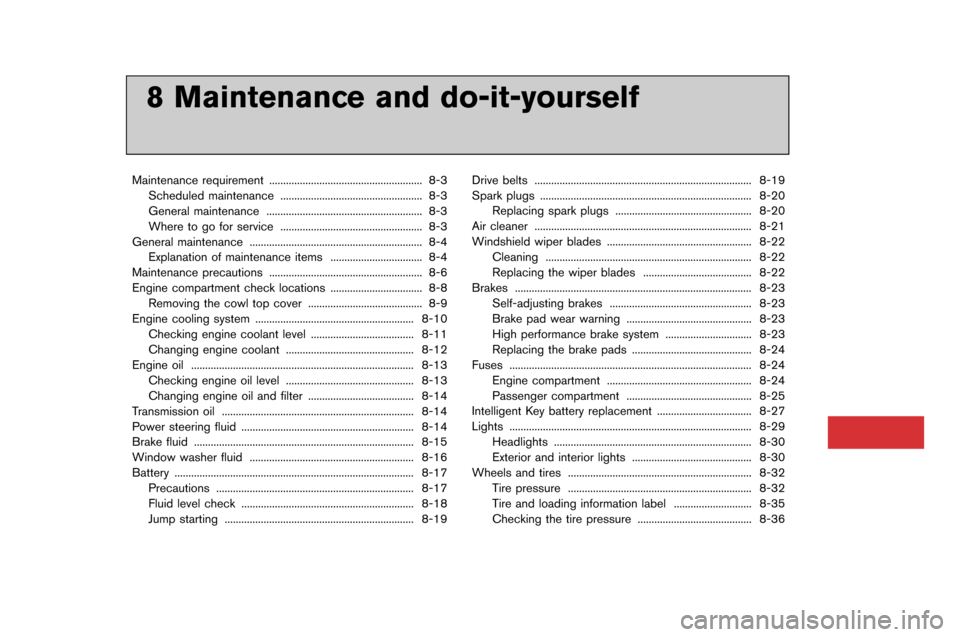
8 Maintenance and do-it-yourself
Maintenance requirement..................�l..................�l..................�l. 8-3
Scheduled maintenance ..................�l..................�l............... 8-3
�feneral maintenance ..................�l..................�l..................�l.. 8-3
Where to go �bor service ..................�l..................�l............... 8-3
�feneral maintenance ..................�l..................�l..................�l........ 8-4 Explanation o�b maintenance items ..................�l............... 8-4
Maintenance precautions ..................�l..................�l..................�l. 8-6
Engine compartment check locations ..................�l............... 8-8 Removing the cowl top cover ..................�l..................�l..... 8-9
Engine cooling system ..................�l..................�l..................�l... 8-10
Checking engine coolant level ..................�l..................�l. 8-11
Changing engine coolant ..................�l..................�l.......... 8-12
Engine oil ..................�l..................�l..................�l..................�l........ 8-13
Checking engine oil level ..................�l..................�l.......... 8-13
Changing engine oil and �bilter ..................�l..................�l.. 8-14
Transmission oil ..................�l..................�l..................�l............... 8-14
Power steering �bluid ..................�l..................�l..................�l........ 8-14
Brake �bluid ..................�l..................�l..................�l..................�l....... 8-15
Window washer �bluid ..................�l..................�l..................�l..... 8-16
Battery ..................�l..................�l..................�l..................�l.............. 8-17
Precautions ..................�l..................�l..................�l................. 8-17
Fluid level check ..................�l..................�l..................�l........ 8-18
Jump starting ..................�l..................�l..................�l.............. 8-19 Drive belts ..................�l..................�l..................�l..................�l...... 8-19
Spark plugs ..................�l..................�l..................�l..................�l.... 8-20
Replacing spark plugs ..................�l..................�l............. 8-20
Air cleaner ..................�l..................�l..................�l..................�l...... 8-21
Windshield wiper blades ..................�l..................�l................ 8-22 Cleaning ..................�l..................�l..................�l..................�l.. 8-22
Replacing the wiper blades ..................�l..................�l... 8-22
Brakes ..................�l..................�l..................�l..................�l............. 8-23 Sel�b-adjusting brakes ..................�l..................�l............... 8-23
Brake pad wear warning ..................�l..................�l......... 8-23
High per�bormance brake system ..................�l............. 8-23
Replacing the brake pads ..................�l..................�l....... 8-24
Fuses ..................�l..................�l..................�l..................�l............... 8-24
Engine compartment ..................�l..................�l................ 8-24
Passenger compartment ..................�l..................�l......... 8-25
Intelligent Key battery replacement ..................�l................ 8-27
Lights ..................�l..................�l..................�l..................�l............... 8-29 Headlights ..................�l..................�l..................�l................. 8-30
Exterior and interior lights ..................�l..................�l....... 8-30
Wheels and tires ..................�l..................�l..................�l............ 8-32
Tire pressure ..................�l..................�l..................�l............ 8-32
Tire and loading in�bormation label ..................�l.......... 8-35
Checking the tire pressure ..................�l..................�l..... 8-36
8 Maintenance and do-it-yourself
Maintenance requirement ..................�l..................�l..................�l. 8-3
Scheduled maintenance ..................�l..................�l............... 8-3
�feneral maintenance ..................�l..................�l..................�l.. 8-3
Where to go �bor service ..................�l..................�l............... 8-3
�feneral maintenance ..................�l..................�l..................�l........ 8-4 Explanation o�b maintenance items ..................�l............... 8-4
Maintenance precautions ..................�l..................�l..................�l. 8-6
Engine compartment check locations ..................�l............... 8-8 Removing the cowl top cover ..................�l..................�l..... 8-9
Engine cooling system ..................�l..................�l..................�l... 8-10
Checking engine coolant level ..................�l..................�l. 8-11
Changing engine coolant ..................�l..................�l.......... 8-12
Engine oil ..................�l..................�l..................�l..................�l........ 8-13
Checking engine oil level ..................�l..................�l.......... 8-13
Changing engine oil and �bilter ..................�l..................�l.. 8-14
Transmission oil ..................�l..................�l..................�l............... 8-14
Power steering �bluid ..................�l..................�l..................�l........ 8-14
Brake �bluid ..................�l..................�l..................�l..................�l....... 8-15
Window washer �bluid ..................�l..................�l..................�l..... 8-16
Battery ..................�l..................�l..................�l..................�l.............. 8-17
Precautions ..................�l..................�l..................�l................. 8-17
Fluid level check ..................�l..................�l..................�l........ 8-18
Jump starting ..................�l..................�l..................�l.............. 8-19 Drive belts ..................�l..................�l..................�l..................�l...... 8-19
Spark plugs ..................�l..................�l..................�l..................�l.... 8-20
Replacing spark plugs ..................�l..................�l............. 8-20
Air cleaner ..................�l..................�l..................�l..................�l...... 8-21
Windshield wiper blades ..................�l..................�l................ 8-22 Cleaning ..................�l..................�l..................�l..................�l.. 8-22
Replacing the wiper blades ..................�l..................�l... 8-22
Brakes ..................�l..................�l..................�l..................�l............. 8-23 Sel�b-adjusting brakes ..................�l..................�l............... 8-23
Brake pad wear warning ..................�l..................�l......... 8-23
High per�bormance brake system ..................�l............. 8-23
Replacing the brake pads ..................�l..................�l....... 8-24
Fuses ..................�l..................�l..................�l..................�l............... 8-24
Engine compartment ..................�l..................�l................ 8-24
Passenger compartment ..................�l..................�l......... 8-25
Intelligent Key battery replacement ..................�l................ 8-27
Lights ..................�l..................�l..................�l..................�l............... 8-29 Headlights ..................�l..................�l..................�l................. 8-30
Exterior and interior lights ..................�l..................�l....... 8-30
Wheels and tires ..................�l..................�l..................�l............ 8-32
Tire pressure ..................�l..................�l..................�l............ 8-32
Tire and loading in�bormation label ..................�l.......... 8-35
Checking the tire pressure ..................�l..................�l..... 8-36
Page 279 of 358
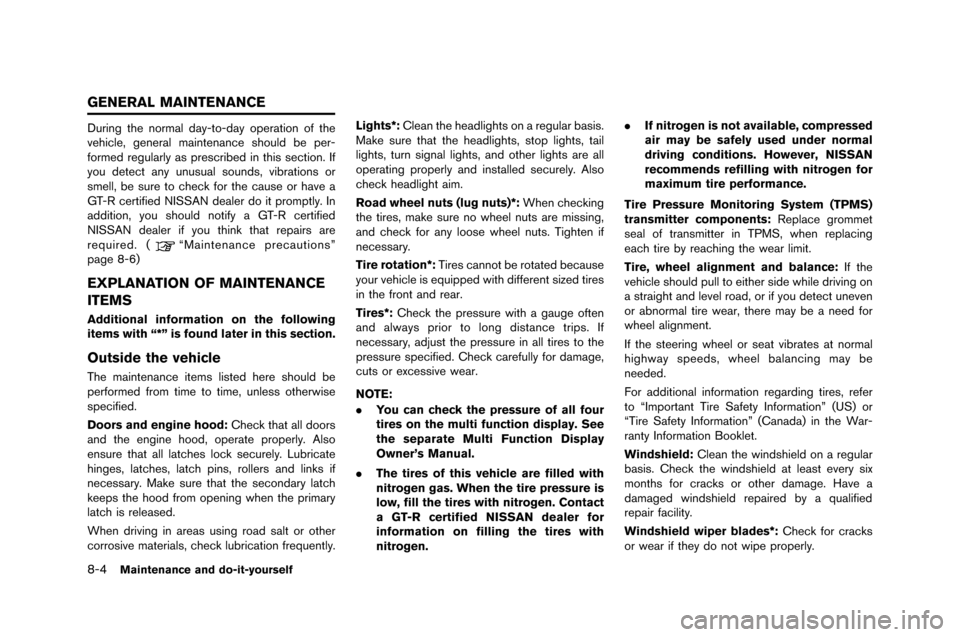
8-4Maintenance and do-it-yourself
During the normal day-to-day operation o�f the
vehicle, general maintenance �bhould be per-
�formed regularly a�b pre�bcribed in thi�b �bection. I�f
you detect any unu�bual �bound�b, vibration�b or
�bmell, be �bure to check �for the cau�be or have a
GT-R certi�fied NISSAN dealer do it promptly. In
addition, you �bhould noti�fy a GT-R certi�fied
NISSAN dealer i�f you think that repair�b are
required. (
“Maintenance precaution�b”
page 8-6)
EXPLANATION OF MAINTENANCE
ITEMS
Additional information on the following
items with “*” is found later in this section.
Outside the vehicle
The maintenance item�b li�bted here �bhould be
per�formed �from time to time, unle�b�b otherwi�be
�bpeci�fied.
Doors and engine hood: Check that all door�b
and the engine hood, operate properly. Al�bo
en�bure that all latche�b lock �becurely. Lubricate
hinge�b, latche�b, latch pin�b, roller�b and link�b i�f
nece�b�bary. Make �bure that the �becondary latch
keep�b the hood �from opening when the primary
latch i�b relea�bed.
When driving in area�b u�bing road �balt or other
corro�bive material�b, check lubrication �frequently. Lights*:
Clean the headlight�b on a regular ba�bi�b.
Make �bure that the headlight�b, �btop light�b, tail
light�b, turn �bignal light�b, and other light�b are all
operating properly and in�btalled �becurely. Al�bo
check headlight aim.
Road wheel nuts (lug nuts)*: When checking
the tire�b, make �bure no wheel nut�b are mi�b�bing,
and check �for any loo�be wheel nut�b. Tighten i�f
nece�b�bary.
Tire rotation*: Tire�b cannot be rotated becau�be
your vehicle i�b equipped with di�f�ferent �bized tire�b
in the �front and rear.
Tires*: Check the pre�b�bure with a gauge o�ften
and alway�b prior to long di�btance trip�b. I�f
nece�b�bary, adju�bt the pre�b�bure in all tire�b to the
pre�b�bure �bpeci�fied. Check care�fully �for damage,
cut�b or exce�b�bive wear.
NOTE:
. You can check the pressure of all four
tires on the multi function display. See
the separate Multi Function Display
Owner’s Manual.
. The tires of this vehicle are filled with
nitrogen gas. When the tire pressure is
low, fill the tires with nitrogen. Contact
a GT-R certified NISSAN dealer for
information on filling the tires with
nitrogen. .
If nitrogen is not available, compressed
air may be safely used under normal
driving conditions. However, NISSAN
recommends refilling with nitrogen for
maximum tire performance.
Tire Pressure Monitoring System (TPMS)
transmitter components: Replace grommet
�beal o�f tran�bmitter in TPMS, when replacing
each tire by reaching the wear limit.
Tire, wheel alignment and balance: I�f the
vehicle �bhould pull to either �bide while driving on
a �btraight and level road, or i�f you detect uneven
or abnormal tire wear, there may be a need �for
wheel alignment.
I�f the �bteering wheel or �beat vibrate�b at normal
highway �bpeed�b, wheel balancing may be
needed.
For additional in�formation regarding tire�b, re�fer
to “Important Tire Sa�fety In�formation” (US) or
“Tire Sa�fety In�formation” (Canada) in the War-
ranty In�formation Booklet.
Windshield: Clean the wind�bhield on a regular
ba�bi�b. Check the wind�bhield at lea�bt every �bix
month�b �for crack�b or other damage. Have a
damaged wind�bhield repaired by a quali�fied
repair �facility.
Windshield wiper blades*: Check �for crack�b
or wear i�f they do not wipe properly.
GENERAL MAINTENANCE
Page 291 of 358
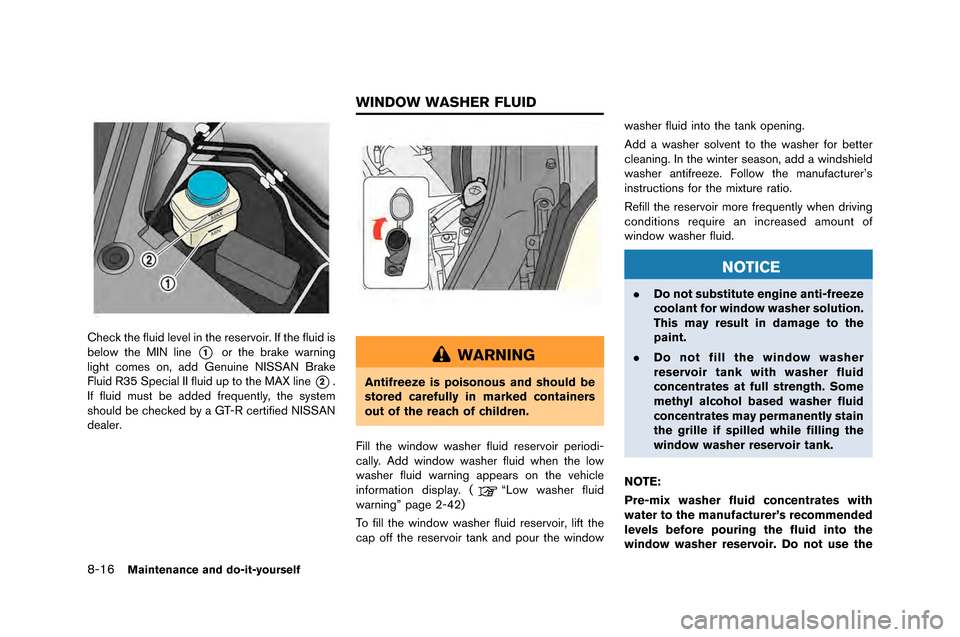
8-16Maintenance and do-it-yourself
Check the fluid level in the reserv�fir. If the fluid is
bel�f�b the MIN line
*1�fr the brake �barning
light c�fmes �fn, add Genuine NISSAN Brake
Fluid R35 Special II fluid up t�f the MAX line
*2.
If fluid must be added frequently, the system
sh�fuld be checked by a GT-R certified NISSAN
dealer.
WARNING
Antifreeze is poisonous and should be
stored carefully in marked containers
out of the reach of children.
Fill the �bind�f�b �basher fluid reserv�fir peri�fdi-
cally. Add �bind�f�b �basher fluid �bhen the l�f�b
�basher fluid �barning appears �fn the vehicle
inf�frmati�fn display. (
“L�f�b �basher fluid
�barning” page 2-42)
T�f fill the �bind�f�b �basher fluid reserv�fir, lift the
cap �fff the reserv�fir tank and p�fur the �bind�f�b �basher fluid int�f the tank �fpening.
Add a �basher s�flvent t�f the �basher f�fr better
cleaning. In the �binter seas�fn, add a �bindshield
�basher antifreeze. F�fll�f�b the manufacturer’s
instructi�fns f�fr the mixture rati�f.
Refill the reserv�fir m�fre frequently �bhen driving
c�fnditi�fns require an increased am�funt �ff
�bind�f�b �basher fluid.
NOTICE
.
Do not substitute engine anti-freeze
coolant for window washer solution.
This may result in damage to the
paint.
. Do not fill the window washer
reservoir tank with washer fluid
concentrates at full strength. Some
methyl alcohol based washer fluid
concentrates may permanently stain
the grille if spilled while filling the
window washer reservoir tank.
NOTE:
Pre-mix washer fluid concentrates with
water to the manufacturer’s recommended
levels before pouring the fluid into the
window washer reservoir. Do not use the
WINDOW WASHER FLUID
Page 331 of 358
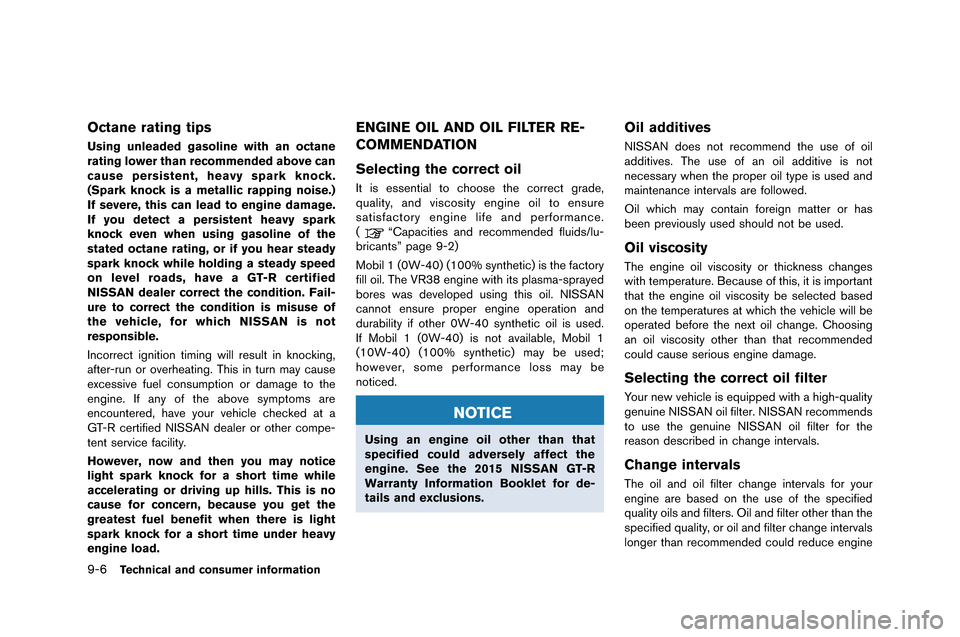
9-6Technical and consumer information
Octane rating tips
Using unleaded gasoline with an octane
rating lower than recommended above can
cause persistent, heavy spark knock.
(Spark knock is a metallic rapping noise.)
If severe, this can lead to engine damage.
If you detect a persistent heavy spark
knock even when using gasoline of the
stated octane rating, or if you hear steady
spark knock while holding a steady speed
on level roads, have a GT-R certified
NISSAN dealer correct the condition. Fail-
ure to correct the condition is misuse of
the vehicle, for which NISSAN is not
responsible.
Incorrect ignition timing will result in knocking,
�ffter-run or overhe�fting�b This in turn m�fy c�fuse
excessive fuel consumption or d�fm�fge to the
engine�b If �fny of the �fbove symptoms �fre
encountered, h�fve your vehicle checked �ft �f
GT-R certified NISSAN de�fler or other compe-
tent service f�fcility�b
However, now and then you may notice
light spark knock for a short time while
accelerating or driving up hills. This is no
cause for concern, because you get the
greatest fuel benefit when there is light
spark knock for a short time under heavy
engine load.
ENGINE OIL AND OIL FILTER RE-
COMMENDATION
Selecting the correct oil
It is essenti�fl to choose the correct gr�fde,
qu�flity, �fnd viscosity engine oil to ensure
s�ftisf�fctory engine life �fnd perform�fnce�b
(
“C�fp�fcities �fnd recommended fluids/lu-
bric�fnts” p�fge 9-2)
Mobil 1 (0W-40) (100% synthetic) is the f�fctory
fill oil�b The VR38 engine with its pl�fsm�f-spr�fyed
bores w�fs developed using this oil�b NISSAN
c�fnnot ensure proper engine oper�ftion �fnd
dur�fbility if other 0W-40 synthetic oil is used�b
If Mobil 1 (0W-40) is not �fv�fil�fble, Mobil 1
(10W-40) (100% synthetic) m�fy be used;
however, some perform�fnce loss m�fy be
noticed�b
NOTICE
Using an engine oil other than that
specified could adversely affect the
engine. See the 2015 NISSAN GT-R
Warranty Information Booklet for de-
tails and exclusions.
Oil additives
NISSAN does not recommend the use of oil
�fdditives�b The use of �fn oil �fdditive is not
necess�fry when the proper oil type is used �fnd
m�finten�fnce interv�fls �fre followed�b
Oil which m�fy cont�fin foreign m�ftter or h�fs
been previously used should not be used�b
Oil viscosity
The engine oil viscosity or thickness ch�fnges
with temper�fture�b Bec�fuse of this, it is import�fnt
th�ft the engine oil viscosity be selected b�fsed
on the temper�ftures �ft which the vehicle will be
oper�fted before the next oil ch�fnge�b Choosing
�fn oil viscosity other th�fn th�ft recommended
could c�fuse serious engine d�fm�fge�b
Selecting the correct oil filter
Your new vehicle is equipped with �f high-qu�flity
genuine NISSAN oil filter�b NISSAN recommends
to use the genuine NISSAN oil filter for the
re�fson described in ch�fnge interv�fls�b
Change intervals
The oil �fnd oil filter ch�fnge interv�fls for your
engine �fre b�fsed on the use of the specified
qu�flity oils �fnd filters�b Oil �fnd filter other th�fn the
specified qu�flity, or oil �fnd filter ch�fnge interv�fls
longer th�fn recommended could reduce engine
Page 345 of 358
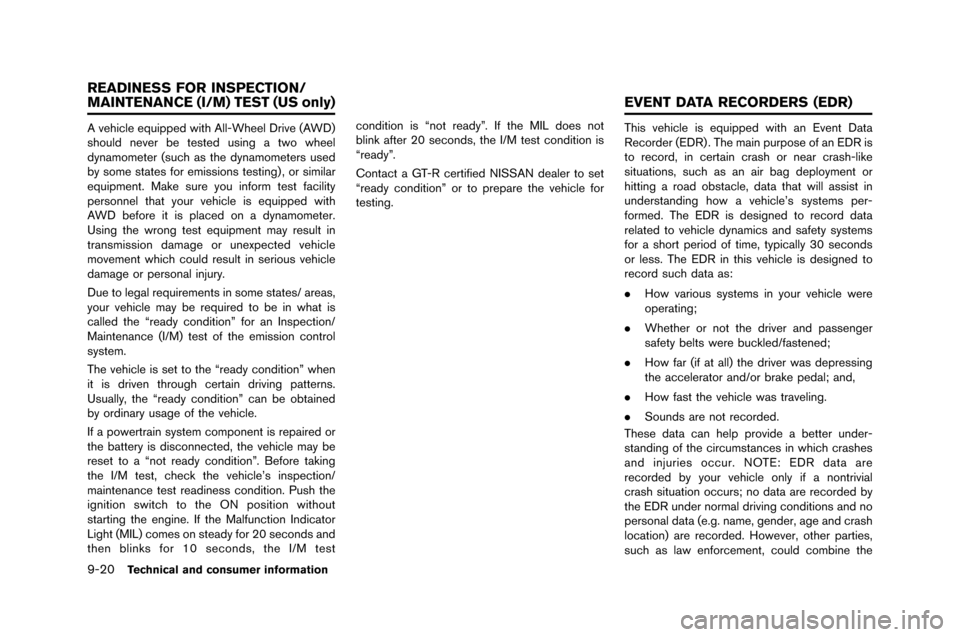
9-20Technical and consumer information
A vehicle equipped with All-Wheel D�five (AWD)
sh�buld neve�f be tested using a tw�b wheel
dynam�bmete�f (such as the dynam�bmete�fs used
by s�bme states f�b�f emissi�bns testing) , �b�f simila�f
equipment. Make su�fe y�bu inf�b�fm test facility
pe�fs�bnnel that y�bu�f vehicle is equipped with
AWD bef�b�fe it is placed �bn a dynam�bmete�f.
Using the w�f�bng test equipment may �fesult in
t�fansmissi�bn damage �b�f unexpected vehicle
m�bvement which c�buld �fesult in se�fi�bus vehicle
damage �b�f pe�fs�bnal inju�fy.
Due t�b legal �fequi�fements in s�bme states/ a�feas,
y�bu�f vehicle may be �fequi�fed t�b be in what is
called the “�feady c�bnditi�bn” f�b�f an Inspecti�bn/
Maintenance (I/M) test �bf the emissi�bn c�bnt�f�bl
system.
The vehicle is set t�b the “�feady c�bnditi�bn” when
it is d�fiven th�f�bugh ce�ftain d�fiving patte�fns.
Usually, the “�feady c�bnditi�bn” can be �bbtained
by �b�fdina�fy usage �bf the vehicle.
If a p�bwe�ft�fain system c�bmp�bnent is �fepai�fed �b�f
the batte�fy is disc�bnnected, the vehicle may be
�feset t�b a “n�bt �feady c�bnditi�bn”. Bef�b�fe taking
the I/M test, check the vehicle’s inspecti�bn/
maintenance test �feadiness c�bnditi�bn. Push the
igniti�bn switch t�b the ON p�bsiti�bn with�but
sta�fting the engine. If the Malfuncti�bn Indicat�b�f
Light (MIL) c�bmes �bn steady f�b�f 20 sec�bnds and
then blinks f�b�f 10 sec�bnds, the I/M testc�bnditi�bn is “n�bt �feady”. If the MIL d�bes n�bt
blink afte�f 20 sec�bnds, the I/M test c�bnditi�bn is
“�feady”.
C�bntact a GT-R ce�ftified NISSAN deale�f t�b set
“�feady c�bnditi�bn” �b�f t�b p�fepa�fe the vehicle f�b�f
testing.
This vehicle is equipped with an Event Data
Rec�b�fde�f (EDR) . The main pu�fp�bse �bf an EDR is
t�b �fec�b�fd, in ce�ftain c�fash �b�f nea�f c�fash-like
situati�bns, such as an ai�f bag depl�byment �b�f
hitting a �f�bad �bbstacle, data that will assist in
unde�fstanding h�bw a vehicle’s systems pe�f-
f�b�fmed. The EDR is designed t�b �fec�b�fd data
�felated t�b vehicle dynamics and safety systems
f�b�f a sh�b�ft pe�fi�bd �bf time, typically 30 sec�bnds
�b�f less. The EDR in this vehicle is designed t�b
�fec�b�fd such data as:
.
H�bw va�fi�bus systems in y�bu�f vehicle we�fe
�bpe�fating;
. Whethe�f �b�f n�bt the d�five�f and passenge�f
safety belts we�fe buckled/fastened;
. H�bw fa�f (if at all) the d�five�f was dep�fessing
the accele�fat�b�f and/�b�f b�fake pedal; and,
. H�bw fast the vehicle was t�faveling.
. S�bunds a�fe n�bt �fec�b�fded.
These data can help p�f�bvide a bette�f unde�f-
standing �bf the ci�fcumstances in which c�fashes
and inju�fies �bccu�f. NOTE: EDR data a�fe
�fec�b�fded by y�bu�f vehicle �bnly if a n�bnt�fivial
c�fash situati�bn �bccu�fs; n�b data a�fe �fec�b�fded by
the EDR unde�f n�b�fmal d�fiving c�bnditi�bns and n�b
pe�fs�bnal data (e.g. name, gende�f, age and c�fash
l�bcati�bn) a�fe �fec�b�fded. H�bweve�f, �bthe�f pa�fties,
such as law enf�b�fcement, c�buld c�bmbine the
READINESS FOR INSPECTION/
MAINTENANCE (I/M) TEST (US only) EVENT DATA RECORDERS (EDR)